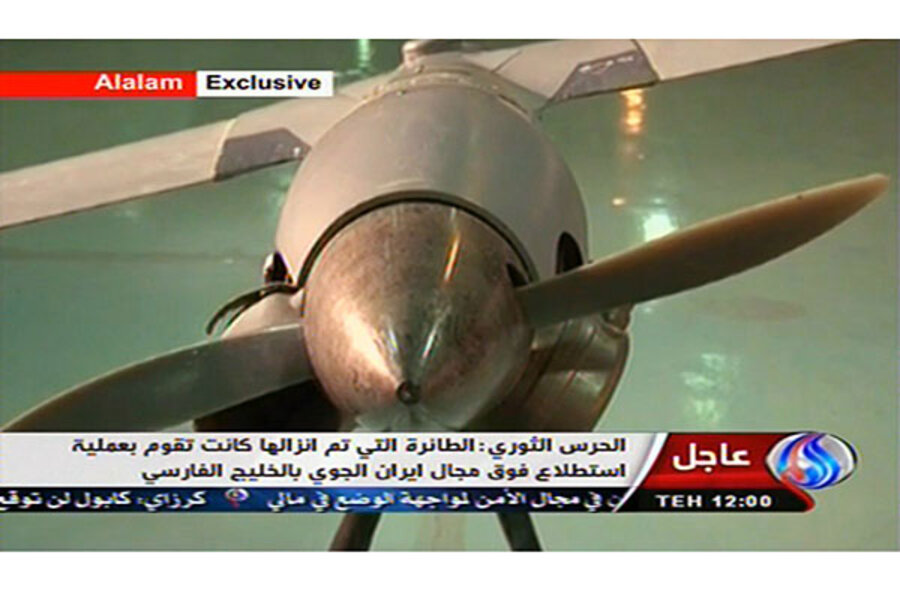Covert US-Iran war bubbles over with claims of drone capture
Loading...
| Washington
Iranian claims – and US denials – that Iran captured an American reconnaissance drone flying over Iranian territory in recent days offers little in the way of clarity, other than this: The covert war between the two adversaries continues.
Iran’s Revolutionary Guard Corps on Tuesday released video through the semiofficial Fars news agency purporting to show an unarmed drone that Revolutionary Guard officials said they “hunted down” recently after detecting it over Iranian territory.
The four-foot-long unmanned vehicle, called a ScanEagle, was shown on Iranian television with a map of the Persian Gulf in the background and the legend, “We shall trample on the U.S.”
Those words placed the ScanEagle incident among the other tactics of a smoldering war with Iran and its proxies, among them Hezbollah in Lebanon, and the United States and its partners, including Israel. Such tactics have ranged from unclaimed bombings and the use of cyberworms to assassinations.
The US Navy, which operates ScanEagle drones in the region, responded from the headquarters of the Fifth Fleet in Bahrain that all its drones operating in the Middle East were accounted for. It also noted in a statement, “Our operations in the Gulf are confined to internationally recognized water and air space.”
At the same time, some military experts note, the drone that Iran displayed exhibited no US military markings, suggesting the vehicle, which is not unique to the US military, might belong to another country. Other Gulf countries possess ScanEagles as part of their reconnaissance fleets.
Iran’s downing of a ScanEagle is reminiscent of another drone incident a year ago, when Tehran trumpeted its capture of a more sophisticated Sentinel drone – one clearly owned by the US.
In that case, the US insisted the drone strayed into Iranian airspace and then crashed after it malfunctioned – and America demanded its return. Iran, displaying an intact vehicle, claimed on the contrary that it had hacked into the drone’s computer and brought it down. Refusing to return it, Iran later claimed to have dismantled the Sentinel to study its construction and operation.
Just last month, the Pentagon acknowledged another incident in which Iranian military forces shot at a US Predator drone.
In the ongoing covert war between the US and Iran, most of the actions remain mysterious and unclaimed – until one side or the other sees an advantage in shining light on an incident. Thus Iran, which has an interest in demonstrating to its foes its ability to intercept foreign aircraft, was quick to show the world its latest prize.
In unveiling the ScanEagle to Iranian media, the commander of the Revolutionary Guard’s naval forces, Rear Adm. Ali Fadavi, said Iran’s ability to detect and bring down the drone demonstrated its “full intelligence supremacy” over the operations that targeted it.
But in other cases, the two sides appear to be content to let their actions speak for themselves.
No one has ever claimed the airstrikes that caused a major fire at an arms factory outside Khartoum, Sudan, this past October. But regional military experts assume the bombing was carried out by Israel, and for two reasons: one, to strike a suspected go-between for Iranian arms smuggling; and two, to send a message that Israel will not hesitate to use force against its enemies.
That message may have been destined for Iran, whose nuclear program Israel considers to be an existential threat.
Other unclaimed actions considered by intelligence experts to have been carried out in the course of the ongoing covert war range from the Stuxnet cyberworm, which destroyed a large number of Iran’s uranium-spinning centrifuges; to a cyberattack on Saudi oil facilities earlier this year, which reportedly destroyed thousands of computers. Mysterious explosions have struck Iranian nuclear facilities, while Iranian nuclear scientists have been assassinated.
Meanwhile, some intelligence analysts believe Iran was clearly signaling to its adversaries when its longtime partner in Lebanon, the militant organization Hezbollah, sent what experts say was an Iranian-supplied drone over Israeli airspace in October.
Israel shot down the drone, but not before Tehran got its message across, experts say: that Iran has the means to defend itself, and to retaliate, should its enemies decide to attack its nuclear facilities.






